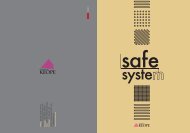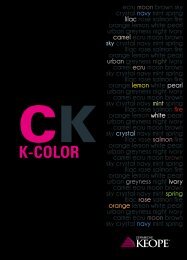Catalogo Ti-Led 2.0 [3.5 Mb] - Ceramiche KEOPE
Catalogo Ti-Led 2.0 [3.5 Mb] - Ceramiche KEOPE
Catalogo Ti-Led 2.0 [3.5 Mb] - Ceramiche KEOPE
You also want an ePaper? Increase the reach of your titles
YUMPU automatically turns print PDFs into web optimized ePapers that Google loves.
TRANSPARENT BLU BROWN RED<br />
Posa<br />
<strong>Ti</strong>•LED <strong>2.0</strong> può essere posato come una normale piastrella utilizzando i collanti tradizionali,<br />
non è necessaria una preparazione preventiva del massetto, tuttavia l’installazione di questi<br />
prodotti richiede l’intervento di personale specializzato.<br />
Lo spessore di ingombro del sistema <strong>Ti</strong>•LED <strong>2.0</strong> nella parte sottostante alle piastrelle è di<br />
poco superiore a 3 mm (compreso cavi e connettori) e i cavi possono essere immersi nella<br />
colla.<br />
Il massetto deve essere perfettamente liscio, nel caso in cui presenti convessità o grumi<br />
di calcestruzzo, procedere con la raschiatura dello stesso nei punti in cui si andranno a<br />
posizionare le piastrelle con LED. Si consiglia la doppia spalmatura del collante tramite<br />
l’utilizzo di una spatola dentata di minimo 10x10 cm ad un’inclinazione di circa 45°.<br />
Prima della posa si consiglia inoltre di collegare la fila di piastrelle in oggetto all’alimentatore<br />
in modo da verificare il corretto funzionamento di tutti i LED. Si consiglia infine di togliere<br />
l’adesivo che protegge il tappo in policarbonato solo dopo il lavaggio (acido) post posa.<br />
caratteristiche<br />
tecniche<br />
technical features<br />
caractéristiques techniques<br />
technische eigenschaften<br />
036<br />
FUMÉ FLUO WHITE VIOLET<br />
Colori<br />
Il colore emesso da <strong>Ti</strong>•LED <strong>2.0</strong><br />
dipende dal colore della lente in<br />
policarbonato che lo protegge.<br />
I tappi sono disponibili in sette colori:<br />
TRANSPARENT, BLUE, BROWN,<br />
RED, FUMÉ, FLUO, WHITE, VIOLET.<br />
Sono intercambiabili e possono<br />
facilmente essere sostituiti in<br />
brevissimo tempo da chiunque.<br />
Colours<br />
The colour emitted by <strong>Ti</strong>•LED <strong>2.0</strong> depends on the colour of the<br />
polycarbonate lens that protects it.<br />
The caps are available in seven colours: TRANSPARENT, BLUE, BROWN,<br />
RED, FUMÉ, FLUO, WHITE, VIOLET. They are interchangeable and can<br />
be easily and quickly replaced by anyone.<br />
Couleurs<br />
La couleur diffusée par <strong>Ti</strong>•LED <strong>2.0</strong> dépend de la couleur de la lentille en<br />
polycarbonate qui le protège.<br />
Les lentilles sont disponibles en sept couleurs : TRANSPARENT, BLUE,<br />
BROWN, RED, FUMÉ, FLUO, WHITE, VIOLET. Elles sont interchangeables<br />
et facilement remplaçables en très peu de temps par quiconque.<br />
Farben<br />
Die farbe des Lichtes, das von <strong>Ti</strong>•LED <strong>2.0</strong> ausgestrahlt wird, hängt<br />
von der farbe der Polycarbonat-Scheibe, die das Beleuchtungssystem<br />
schützt, ab.<br />
Die Abdeckungen sind in sieben Farben verfügbar: TRANSPARENT,<br />
BLUE, BROWN, RED, FUMÉ, FLUO, WHITE, VIOLET. Die Abdeckungen<br />
sind austauschbar und können innerhalb kürzester Zeit von jedem<br />
ausgewechselt werden.<br />
Laying<br />
<strong>Ti</strong>•<strong>Led</strong> <strong>2.0</strong> can be laid in the same way as a normal tile using traditional adhesive; there is<br />
no need to prepare the screed in advance, however these products need to be installed by<br />
skilled personnel.<br />
The overall thickness of the <strong>Ti</strong>•<strong>Led</strong> <strong>2.0</strong> system, in the part under the tiles, slightly exceeds 3<br />
mm (including cables and connectors) and the cables can be sunk in the adhesive.<br />
The screed must be perfectly smooth; if there are any convex parts or lumps of concrete,<br />
scrape them flat in the points in which the tiles with LEDs are to be positioned. It is advisable<br />
to apply a double coating of adhesive using a serrated trowel of minimum 10x10 cm with<br />
angle of approximately 45°.<br />
Before laying, it is advisable also to connect the wire of the tiles to the feeder to make sure<br />
all the LEDs are working. Finally, it is advisable to remove the adhesive that protects the<br />
polycarbonate cap only after washing (acid) at the end of laying.<br />
Pose<br />
<strong>Ti</strong>•<strong>Led</strong> <strong>2.0</strong> se pose comme du carrelage avec les colles traditionnelles. Le support n’a pas<br />
besoin d’être préparé, mais ces produits doivent être posés par un professionnel.<br />
L’épaisseur du système <strong>Ti</strong>•<strong>Led</strong> <strong>2.0</strong> sous le carreau dépasse légèrement les 3 mm (fils et<br />
connecteurs compris) et les fils peuvent être noyés dans la colle.<br />
Le support doit être parfaitement lisse. Racler les éventuelles difformités ou grumeaux de<br />
béton avant de poser le carreau avec la led. Il est conseillé d’appliquer une double couche<br />
de colle avec une spatule crantée de 10x10 cm minimum à une inclinaison de 45° environ.<br />
Avant la pose, il est conseillé de vérifier le fonctionnement de toutes les LEDs en branchant la<br />
rangée de carreaux à un alimentateur. Il est aussi conseillé d’enlever l’adhésif qui protège<br />
la lentille en polycarbonate seulement après le nettoyage acide consécutif à la pose.<br />
Verlegung<br />
<strong>Ti</strong>•<strong>Led</strong> <strong>2.0</strong> kann wie eine normale Fliese verlegt werden, indem die üblichen Klebstoffe<br />
verwendet werden. Eine Vorbereitung des Estrichs ist nicht notwendig, allerdings erfordert<br />
die Installation dieser Produkte den Einsatz eines Fachmanns.<br />
Die Einbaudicke des <strong>Ti</strong>•<strong>Led</strong> <strong>2.0</strong>-Systems unterhalb der Fliesen beträgt kaum mehr als 3<br />
mm (einschließlich Kabel und Verbinder) und die Kabel dürfen in den Klebstoff eingetaucht<br />
werden.<br />
Der Estrich muss komplett glatt sein. Falls Unebenheiten oder Betonklumpen vorhanden sein<br />
sollten, den Estrich an den Stellen, an denen die Fliesen mit den LEDs angebracht werden<br />
sollen, abschaben. Ein doppeltes Auftragen des Klebstoffs mithilfe eines mindestens 10x10cm<br />
großen Zahnspachtels bei einer Neigung von ungefähr 45°C ist empfohlen.<br />
Vor dem Verlegen ist es außerdem ratsam, die betroffene Fliesenreihe an das Netzteil<br />
anzuschließen, um das korrekte Funktionieren aller LEDs zu überprüfen. Den Aufkleber<br />
zum Schutz der Polycarbonat-Abdeckung sollte ausschließlich nach der (sauren) Reinigung<br />
im Anschluss an die Verlegung entfernt werden.<br />
037


![Catalogo Ti-Led 2.0 [3.5 Mb] - Ceramiche KEOPE](https://img.yumpu.com/33248407/36/500x640/catalogo-ti-led-20-35-mb-ceramiche-keope.jpg)

![Catalogo Alpi [5.6 Mb] - Ceramiche KEOPE](https://img.yumpu.com/50563602/1/188x260/catalogo-alpi-56-mb-ceramiche-keope.jpg?quality=85)



![Certificato CE 2013_Granigliati [136.7 Kb] - Ceramiche KEOPE](https://img.yumpu.com/32870522/1/184x260/certificato-ce-2013-granigliati-1367-kb-ceramiche-keope.jpg?quality=85)
![Catalogo Unik [1.5 Mb] - Ceramiche KEOPE](https://img.yumpu.com/32199991/1/188x260/catalogo-unik-15-mb-ceramiche-keope.jpg?quality=85)

![CE_Tinte Unite 2013 [134.6 Kb] - Ceramiche KEOPE](https://img.yumpu.com/28519959/1/184x260/ce-tinte-unite-2013-1346-kb-ceramiche-keope.jpg?quality=85)


